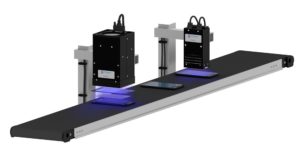Curing is a very important process in many industrial applications and UV curing has meanwhile become the standard process in many applications. For a long time, this was the domain of mercury arc lamps but more and more UV LEDs are replacing the older technology. Stacy Hoge, Marketing Communications Manager at Phoseon Technology, has accompanied many technical developments in this field since she joined the company. She describes the curing process, why this change to UV-LEDs is an important step forward, gives an overview of the most important applications, and she explains what is crucial to being considered when choosing a UV LED curing system.
UV curing is a photopolymerization process that uses UV energy to change a formulation of non-crosslinked solids into a crosslinked solid. Upon absorption of the UV energy photoinitiators produce free radicals that initiate crosslinking with monomers and oligomers This creates a reaction that cures or solidifies the ink, coating or adhesive. UV formulations incorporate various additives such as stabilizers, wetting agents, adhesive on promoters, defoamers, and pigments. This provides the needed formulation characteristics to successfully apply the material and produce the desired color. UV-LED improves on the conventional processes by enabling the technology to be used with thinner, heat-sensitive substrates and constructions as well as sensitive electronics and assemblies. It simultaneously reduces byproducts such as ozone and improving workplace safety through the elimination of UV-B and UV-C wavelengths.
Tags: LED Professional Magazine | UV LED Technology | UV LED Industrial Curing | UV LED Curing Systems | UV LED CuringCategories: Adhesives | Coatings | Inks
